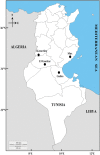Conserved DNA-derived polymorphism, new markers for genetic diversity analysis of Tunisian Pistacia vera L
- PMID: 31564783
- PMCID: PMC6745585
- DOI: 10.1007/s12298-019-00690-4
Conserved DNA-derived polymorphism, new markers for genetic diversity analysis of Tunisian Pistacia vera L
Abstract
Pistachio trees (Pistacia vera L.) have been cultivated in Tunisia for decades and the plantation was extended mostly in the center of the country contributing to the economic growth of marginalized areas. Herein we used conserved DNA derived polymorphism (CDDP) technique, which target specifically conserved sequences of plant functional genes, to assess the genetic diversity and construct genetic relationships among 65 Tunisian pistachio trees. A set of nine primers were used and 157 CDDP markers were revealed with an average of 17.44 showing a high degree of polymorphism (99.37%). The average of polymorphism information content of CDDP markers was of 0.86, which indicates the efficiency of CDDP primers in the estimation of genetic diversity between pistachios. UPGMA dendrogram and the principal component analysis showed four clusters of analyzed pistachios trees. Our results showed that the genetic structure depends on: (1) the gene exchanges between groups, (2) the geographical origin and (3) the sex of the tree. The same result was revealed by the Bayesian analysis implemented in STRUCTURE at K = 4, in which the pistachio genotypes of El Guettar, Kasserine and Sfax were assigned with more than 80% of probability. Our results prove polymorphism and efficiency of CDDP markers in the characterization and genetic diversity analysis of P. vera L. genotypes to define conservation strategy.
Keywords: CDDP markers; Genetic diversity; Pistacia vera L.; Structure analysis.
© Prof. H.S. Srivastava Foundation for Science and Society 2019.
Conflict of interest statement
Conflict of interestThe authors declare that they have no conflict of interest.
Figures





References
-
- Ahmad R, Ferguson L, Southwick SM. Identification of pistachio (Pistacia vera L.) nuts with microsatellite markers. J Am Soc Hortic Sci. 2003;128:898–903. doi: 10.21273/JASHS.128.6.0898. - DOI
-
- Ahmad R, Ferguson L, Southwick SM. Molecular marker analysis of pistachio rootstocks by simple sequence repeats and sequence-related amplified polymorphisms. J Hortic Sci Biotechnol. 2005;80:382–386. doi: 10.1080/14620316.2005.11511948. - DOI
-
- Al-Saghir M, Abu Baker S, Pusok R. Effective method to resolve the chromosome numbers in Pistacia species (Anacardiaceae) Am J Plant Sci. 2014;5:2913–2916. doi: 10.4236/ajps.2014.520306. - DOI
-
- Anai T, Miyata M, Kosemura S, Yamamura S, Tsuge T, Matsui M, Uchida H, Hasegawa K. Comparison of abp1 primary sequences from monocotyledonous and dicotyledonous species. J Plant Physiol. 1997;151:446–449. doi: 10.1016/S0176-1617(97)80010-7. - DOI
LinkOut - more resources
Full Text Sources
